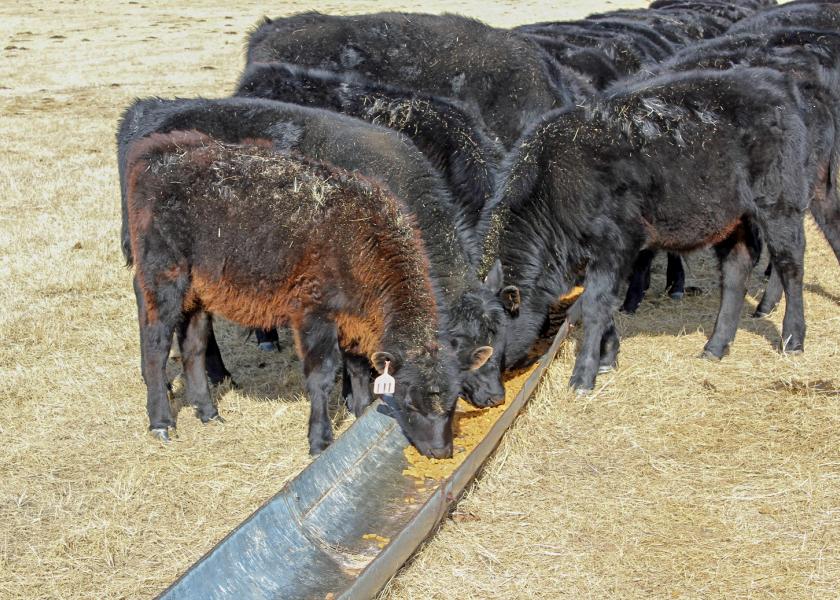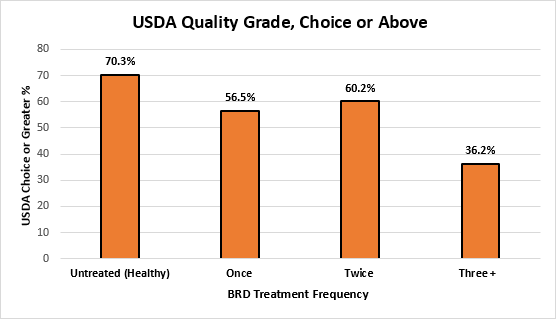Preconditioning Improves Calf Health, Performance and Carcass Quality

Calves enrolled in the OQBN Vac-45 Program attained an average market premium of $18.67/cwt in 2022 and an average of $13.06/cwt over the past 12 years, compared to similar nonpreconditioned calves in the same sales. Common beef calf preconditioning practices include weaning calves for 45 days or more, providing vaccinations for clostridial bacteria (blackleg) and bovine respiratory disease (BRD), castrating, dehorning, and bunk training. Implementing these practices bolsters the immune system, allowing calves to remain healthy during the rigors of the stocker and feedlot phases.
It has been shown that healthy calves usually outgain sick calves during the beginning of the feedlot period (4 to 6 weeks). A study by Richeson et al., (2012) indicated that upon entering the feedlot, preconditioned beef steers exhibited an increased average daily gain (ADG) of 0.77 lbs. and a 90% reduction in BRD morbidity (sickness) compared to nonpreconditioned beef steers. Calves that receive medical treatment for BRD may recover and often exhibit compensatory gain, allowing them to achieve similar final body weights compared to their untreated, healthy counterparts. However, medical treatment and additional days on feed increase production costs and decrease profitability. Calves that must be treated for BRD exhibit a decrease in carcass quality compared to healthy, untreated cattle. An Oklahoma State University study by Wilson et al. (2017), indicated that healthy beef calves (not requiring treatment for BRD) graded choice or prime 70% of the time, while calves treated for BRD once, twice, and three or more times, graded choice or prime 56%, 60%, and 36% of the time respectively (Figure 1).

Figure 1. The impact of BRD Treatment on USDA Quality Grade, in a 2017 Oklahoma State study. Source: Wilson et al., 2017
Reduced carcass quality results in a decrease in carcass value. Wilson et al. (2017) indicated the average carcass values of calves treated for BRD once, twice, and three or more times were reduced by $31, $54, and $103 respectively, compared to the carcass value of untreated, healthy calves (Figure 2).

Figure 2. Actual cattle gross income of feedlot cattle treated for BRD, in a 2017 Oklahoma State study. Source: Wilson et al., 2017
Beef calf preconditioning practices increase calf immunity and health. Calves that remain healthy usually demonstrate greater ADG than those that suffer from BRD-related illness. Healthy calves yield higher-quality carcasses compared to calves requiring BRD treatment. Higher-quality carcasses attain a greater dollar value compared to poorer-quality carcasses. Therefore, it may be assumed that beef calf preconditioning practices not only increase profitability for the cow-calf producer, but also result in an increase in calf feedlot performance, carcass quality, and carcass value.
References:
Richeson, J.T., E.B. Kegley, J.G. Powell, P.A. Beck, B.L. Vander Ley, and J.F. Ridpath. 2012. Weaning management of newly received beef calves with or without continuous exposure to a persistently infected bovine viral diarrhea virus pen mate: Effects on health, performance, bovine diarrhea titers, and peripheral blood leukocytes. J. of Anim. Sci. 90:1972-1985.
Wilson, B.K., D.L. Step, C.L. Maxwell, C.A. Gifford, C.J. Richards, and C.R. Krehbiel. Effect of bovine respiratory disease during receiving period on steer finishing performance, efficiency, carcass characteristics, and lung scores. 2017. The Prof. Anim. Sci. 33:24-36.







